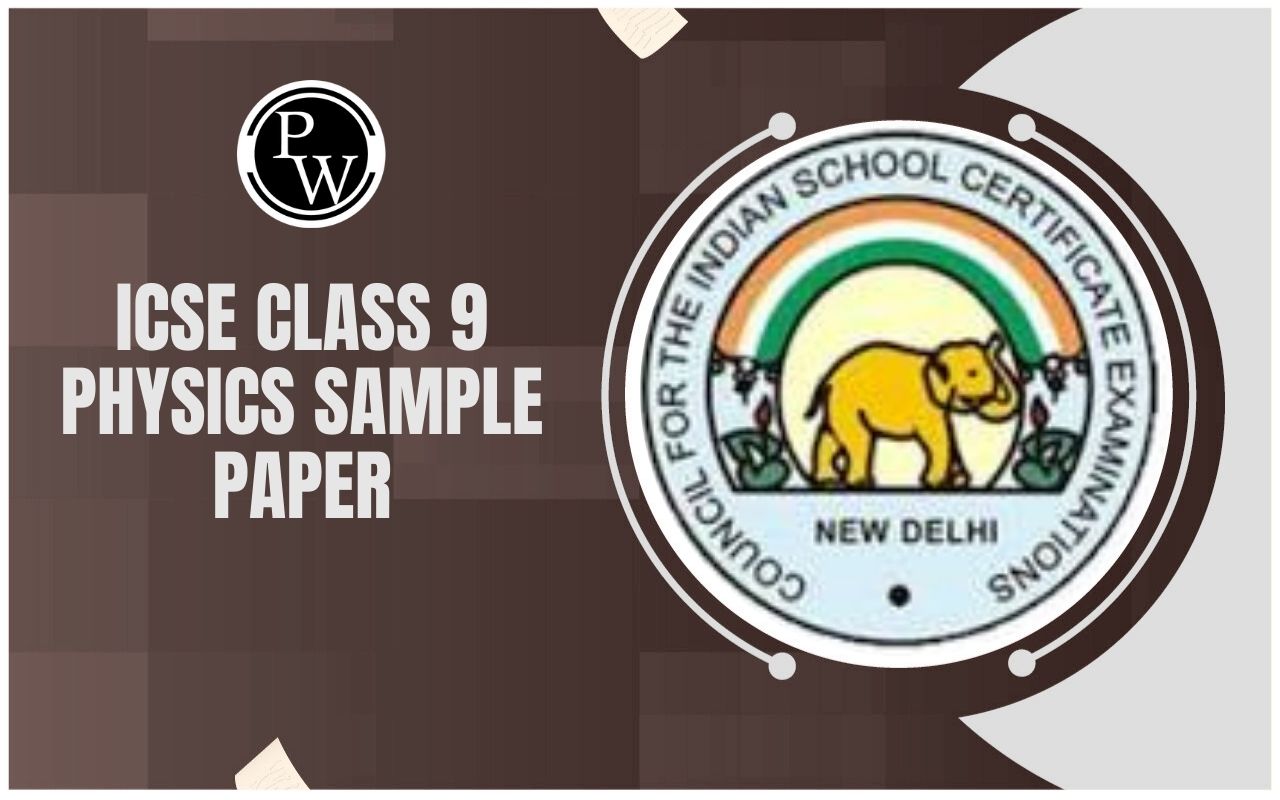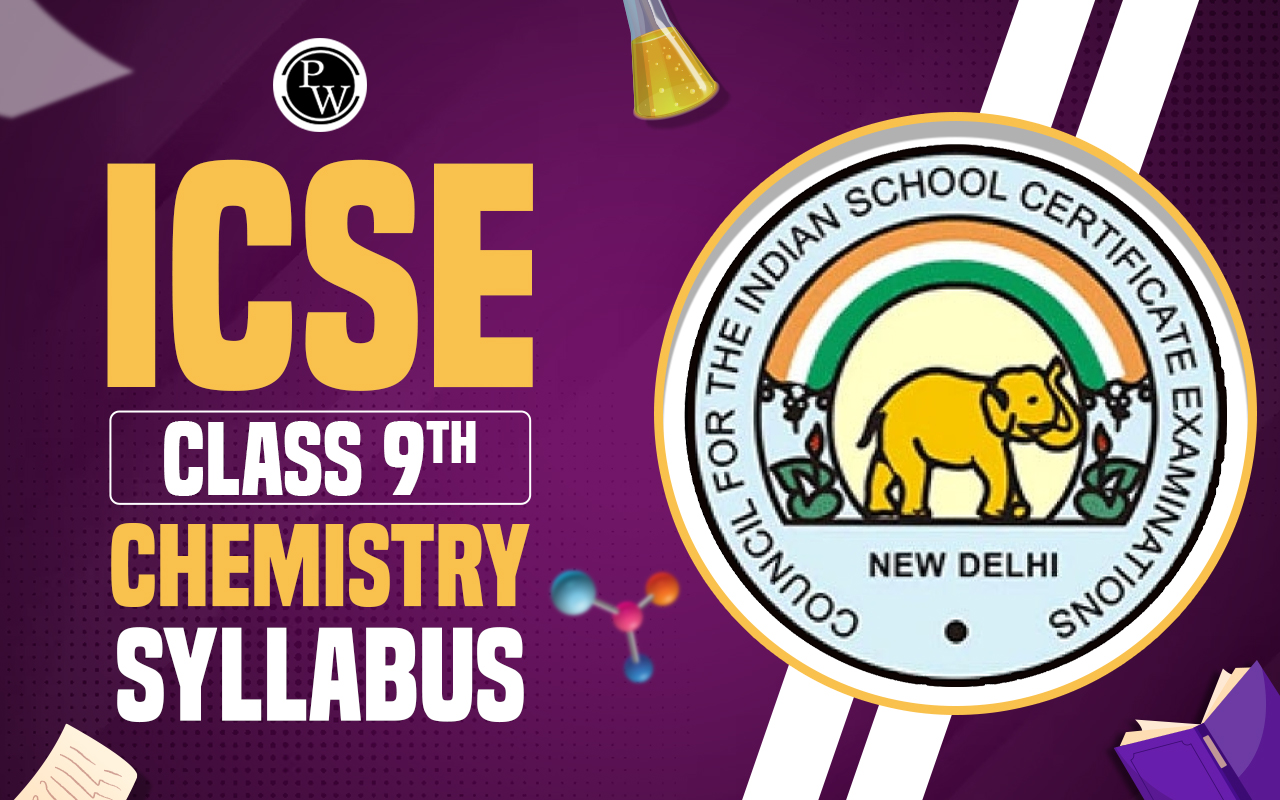
ICSE Class 9 Chemistry Syllabus 2025 has been officially released. Chemistry is a core science subject that helps students understand the composition, structure, and changes in matter.
The syllabus includes essential topics such as the language of chemistry (symbols, formulae, and equations), chemical reactions, the study of water and hydrogen, atomic structure and bonding, the periodic table, gas laws, and environmental issues like atmospheric pollution.
It aims to build a strong foundation in theoretical concepts while encouraging practical understanding through experiments and lab work. Internal assessment carries 20 marks, equally split between the teacher and an external examiner, and includes practical work and project assignments. The syllabus promotes scientific thinking, problem-solving skills, and awareness of the role of chemistry in everyday life.
ICSE Class 9 Chemistry Syllabus Exam Pattern
As per the curriculum, the exam will be a two-hour session and carry a total of 80 marks. The exam will be divided into two sections:- Section I (40 marks) requires answers to all short-answer questions, covering the entire syllabus.
- Part II (40 marks): Students need to answer only four out of six questions in this section.
ICSE Class 9 Chemistry Syllabus Chapter Wise List
The ICSE Class 9 Chemistry Syllabus provides all the necessary details for students to organise their studies. The key points in the ICSE Class 9 Chemistry Syllabus include:- The Language of Chemistry
- Chemical changes and reactions
- Water
- Atomic Structure and Chemical bonding
- The Periodic Table
- Study of the First Element -Hydrogen
- Study of Gas Laws
- Details of Internal Assessment: As per the course outline, the Internal Assessment will rely on the hands-on tasks completed by the student and will carry 20 marks.
We will observe how the materials provided to the students react to chemicals or heat. The curriculum includes a list of simple experiments that students might need to perform for their practical work. Check the table below for more details:
| ICSE Class 9 Chemistry Syllabus 2025 | |
| Chapters | Topics |
| 1. The Language of Chemistry | (i) Valency, radical and compound formulas, as well as an element's symbol. Balancing of simple chemical equations.
|
| 2. Chemical changes and reactions | (i) Types of chemical changes.
|
| 3. Water | (i) Water as a universal solvent.
|
| 4. Atomic Structure and Chemical Bonding | (i) Structure of an Atom, mass number, and atomic number, Isotopes, and Octet Rule.
|
| 5. The Periodic Table |
|
| 6. Study of the First Element-Hydrogen |
|
| 7. Study of Gas Laws | (i) How gases act when temperature and pressure change; described by how tiny particles move (particles, atoms, molecules). Boyle's Law and Charles' Law are included, along with absolute zero, gas equation, and straightforward calculations.
|
| 8. Atmospheric pollution |
|
ICSE Class 9 Chemistry Syllabus Chapter 1 - The Language of Chemistry
- Element symbol – its meaning; valency; formulas for radicals and compounds. Balancing simple chemical equations.
- Symbol – what it represents; commonly used symbols for elements.
- Valency – its meaning; combining hydrogen and the number of valence electrons for metals and non-metals; elements with mono, di, tri, and tetra valency.
- Radicals – their meaning; formulas and valances.
- Compounds – names and formulas.
- Chemical equation – its meaning; examples of equations with one reactant and two or three products, two reactants and one product, two reactants and two products, and two reactants and three or four products; balancing equations using the hit-and-trial method.
- Relative atomic masses (atomic weights) and relative molecular masses (molecular weights): are determined using either the standard hydrogen (H) atom or one-twelfth of the carbon-12 atom.
- Definitions
- Calculation of the relative molecular mass and percentage composition of a compound.
ICSE Class 9 Chemistry Syllabus Chapter 2 - Chemical Changes and Reactions
Types of chemical changes.
- Direct combination
- Decomposition
- Displacement
- Double decomposition
ICSE Class 9 Chemistry Syllabus Chapter 3 - Water
- Water as a universal solvent.
- Mixtures of solids in water are referred to as solutions, especially those that are saturated.
- The impact of temperature on solubility can be observed qualitatively, such as in the case of calcium sulphate, potassium nitrate, and sodium chloride solutions in water.
- Hydrated and anhydrous substances.
- Hydrated substances: Water of Crystallisation – meaning and examples
- Anhydrous substances: Meaning and examples only
- Properties:
- Efflorescence
- Deliquescence
- Hygroscopy
- Removal of hardness
- By boiling
- By addition of washing soda (Definition and examples of each of the above).
- Drying and Dehydrating AgentsMeaning and examples only.
- Soft water and Hard water
- Meaning, (in terms of action of soap)
- Advantages and disadvantages of soft water and hard water.
- Types and causes of hardness.
ICSE Class 9 Chemistry Syllabus Chapter 4 - Atomic Structure and Chemical bonding
(i) Structure of an Atom, mass number and atomic number, Isotopes and Octet Rule.- Definition of an atom
- Parts of an atom include the nucleus, which consists of protons and neutrons, surrounded by electrons. There are two important numbers: the mass number and atomic number.
- Electrons are found in orbits, and their distribution follows the 2n^2 rule and the Octet rule. The chemical activity of an atom is explained by these rules.
- Isotopes, like hydrogen, carbon, and chlorine, have the same atomic number but different mass numbers.
- Definition
- Atomic orbit structure for the formation of Electrovalent compounds (e.g. NaCl, MgCl2, CaO);
- Definition
- Atomic orbit structure plays a role in forming covalent molecules by following the duplet and octet rule for electrons. Examples include hydrogen, chlorine, oxygen, nitrogen, hydrogen chloride, water, ammonia, carbon tetrachloride, and methane.
ICSE Class 9 Chemistry Syllabus Chapter 5 - The Periodic Table
Dobereiner noticed Triads, Newland put forth the Octaves law, and Mendeleev made contributions. There's the Modern Periodic Law and the Modern Periodic Table that has groups and periods.- Basic concept of Dobereiner's triads, Newland's octave rule, and Mendeleev's periodic law.
- Finding the Atomic Number and its role in the foundation of the Modern Periodic law.
- The structure of the Modern Periodic Table, including Groups 1 to 18 and Periods 1 to 7.
- Noteworthy focus on Alkali metals (Group 1), Alkaline Earth metals (Group 2), Halogens (Group 17), and Noble Gases (Group 18).
ICSE Class 9 Chemistry Syllabus Chapter 6 - Study of the First Element - Hydrogen
Where the non-metal (Hydrogen) is located in the periodic table and its group characteristics in terms of valence electrons, burning, and ion formation are considered for the mentioned element. Hydrogen from: water, dilute acids and alkalis.- The effect of cold water on sodium, potassium, and calcium.
- The effect of hot water on magnesium.
- The effect of steam on aluminium, zinc, and iron; (the ability to reverse the reaction between iron and steam).
- The effect of steam on a non-metal (carbon).
(c) Displacement of hydrogen from alkalis: The action of Alkalis ((NaOH, KOH) on Al, Zn and Pb – unique nature of these elements.
(ii) The process of getting hydrogen in a lab without using electrolysis is through a common method. When making it in the lab, it's important to explain why zinc is used, how impurities in the gas are dealt with, and the necessary precautions during the gas collection.
(iii) Industrial manufacture of hydrogen by Bosch process:
- Main reactions and conditions.
- Separation of CO2 and CO from hydrogen.
ICSE Class 9 Chemistry Syllabus Chapter 7 - Study of Gas Laws
(i) Behaviour of gases act when temperature and pressure change; explanation using molecular motion (particles, atoms, molecules); Boyle’s Law and Charles’ Law; absolute zero; gas equation; basic related calculations.- Behaviour of gases act when temperature and pressure change; understanding it through how tiny particles, atoms, and molecules move.
- Boyle’s Law: explaining it, writing the maths, and doing easy maths problems.
- Charles’ Law: explaining it simply.
- Absolute zero on the Kelvin temperature scale.
- Gas equation P1 V1 / T1 = P2 V2 / T2; doing simple maths problems using the gas equation.
ICSE Class 9 Chemistry Syllabus Chapter 8 -Atmospheric pollution
(a) Acid rain Composition, reason, and its effect: Sulphur found in fossil fuels produces sulphur oxides when burned. Elevated temperatures in furnaces and internal combustion engines create nitrogen oxides.(b) Global warming Sources and methods to decrease the presence of greenhouse gases in the air (water vapour, carbon dioxide, methane, and nitrogen oxides).
(c) Ozone depletion
- Formation of ozone – relevant equations
- Function in the atmosphere.
- Destruction of the ozone layer –chemicals responsible for this to be named but reactions not required.
ICSE Class 9 Chemistry Syllabus Internal Assessment of Practical Work
Applicants will need to watch how reagents or heat affect given substances. The tasks will be easy and might involve identifying specific gases from the list below.Gases: Hydrogen, Oxygen, Carbon dioxide, Chlorine, Hydrogen chloride, Sulphur dioxide, Hydrogen sulphide, Ammonia, Water vapour, Nitrogen dioxide. Applicants should have finished the following basic practical exercises.
Simple experiments on:
Action of heat on the following compounds:
(a) copper carbonate, zinc carbonate(b) washing soda, copper sulphate crystals
(c) zinc nitrate, copper nitrate, lead nitrate
(d) ammonium chloride, iodine, ammonium dichromate. Make observations, identify the products and make deductions where possible.
Action of dilute sulphuric acid on the following substances. (warm if necessary)
(a) a metal(b)a carbonate
(c) a sulphide (
Apply the flame test to identify the metal in the unknown substance.
(a) a sodium saltICSE Class 9 Chemistry Syllabus 2025 PDF Download Link
ICSE Class 9 Chemistry Syllabus 2025 has been officially released by the Council for the Indian School Certificate Examinations (CISCE). Students can download the complete syllabus in PDF format using the direct link provided below.
The PDF contains all the important chapters, exam pattern, marking scheme, practical work guidelines, and project assessment details. Having the syllabus in PDF form helps students plan their studies effectively and keep track of topics throughout the academic year. It's a good idea to save or print a copy for easy access and revision.
ICSE Class 9 Chemistry Syllabus 2025
Study without using the internet
Preparation Tips for ICSE Class 9 Chemistry
-
Start by reading the full syllabus and understanding the key concepts covered in each chapter.
-
Focus on writing and balancing chemical equations, understanding the periodic table, and learning about the properties of elements and compounds.
-
Perform lab experiments carefully and understand the science behind them. This helps in scoring well in the internal assessment.
-
Make summary notes with definitions, formulas, and examples for each topic.
-
Relate topics like water pollution, hydrogen fuel, and atmospheric gases to real-life examples and current events.
-
Follow the project and practical guidelines properly. Neat lab records and well-researched projects add to your internal marks.
-
Revise regularly and practice previous years’ questions and chemical equations to gain confidence before the exams.
ICSE Class 9 Chemistry Syllabus 2025 FAQs
Who releases the ICSE Class 9 Chemistry syllabus?
How much weightage is given to internal assessment in Chemistry?
Is practical work compulsory in ICSE Class 9 Chemistry?
What is the exam pattern for Class 9 Chemistry?










